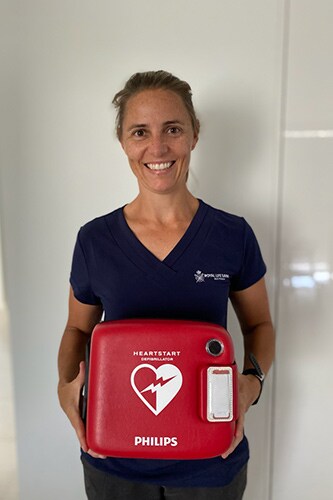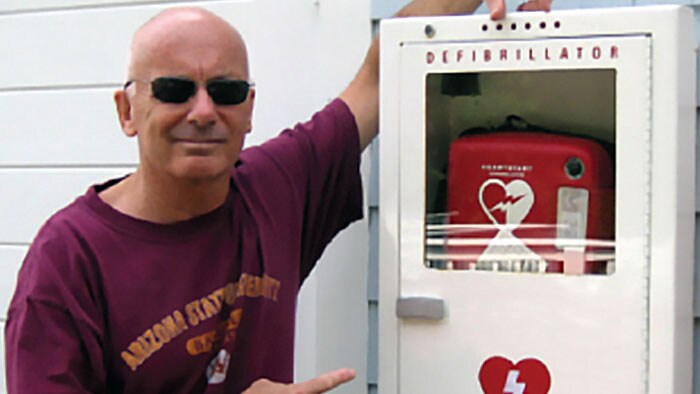Putting her training into practice
As Regional Manager of Royal Life Saving, Carly Ryan estimates that she has used a training AED “thousands” of times in her role as an instructor. So before leaving her office for the Christmas holiday, she decided on a whim to take the Philips HeartStart FRx AED home with her. “Living near the water and a location that sees a lot of people and families relaxing and recreating, I thought it (the AED) may be more beneficial to be accessible to me over the break in case an incident occurred near my home, as opposed to sitting in a vacated office,” Carly explains. Carly had no way of knowing just how close to home an incident would occur. It was just before 4:30 a.m. on January 14, 2021, and Carly’s mum and dad, Robyn and Kym, were asleep in the Warilla, Australia house they share with Carly and her partner. “I woke up with a real tightness in my chest,” Robyn says. She then kicked the sheet off the bed and complained to her husband, Kym about the pain in her chest. He asked her if she was okay, but got no response. Kym turned on the bedroom light and when he did, he noticed that his wife was unconscious, and her skin was blue. He immediately yelled to Carly and her partner for help and began CPR. “I screamed to my daughter for an ambulance. I started CPR immediately, as I knew she needed it. She was blue and grey from the neck up,” he said. Carly remembers running upstairs and seeing her mum on the bed and her dad doing CPR. “Within the next few seconds, I remembered I had the AED in my car. I jumped off the bed, ran past my partner who was on the phone the emergency services and retrieved the AED from my back seat. As soon as I came back up, I opened the device and placed the pads on mum’s chest and told Dad to stop CPR as it analyzed the situation.” Putting her training into practice As an AED instructor, Carly says that up until that point, she had only used the HeartStart FRx AED in training, never in a real-life situation. “It was simple and thankfully, effective. We had the AED on mum for almost nine minutes in total and shocked her twice in that time. It was honestly the same as when I train, only a real casualty was on the other end.” Robyn opened her eyes, but didn’t respond to her name being called. As she was beginning to regain consciousness, the paramedics arrived. Robyn recalls that the evening before they had gone out for a family dinner and she felt fine. “I am pretty active. I work full-time at a hospital and I enjoy walks with my husband.” Although the 63-year-old had no pre-existing conditions, she says that she had experienced random chest pain during the night in the months leading up to the incident. “This happened enough that I booked in with my doctor to check how I was. I actually had a blood test on the Wednesday morning (the day before my arrest). I also had a form in my bag to book in for a stress test.” Robyn explains. Robyn knows that she’s lucky given the statistics. Sudden Cardiac Arrest (SCA) occurs in a home or residence 69.8% of the time.1 Fifty percent of middle-aged adults who experienced SCA had no warning signs.2 The other 50% had warning signs in the months, weeks and days leading up to their SCA, but only 19% called their doctor to report the symptoms.2 Most startingly, of the people who experience an out-of-hospital cardiac arrest, 90% unfortunately do not survive.1 The good news is that immediate CPR and early defibrillation, with an AED, can more than double a victim’s chance of survival.5
Philips HeartStart FRx: side by side, step by step
With her life-saving background, Carly knows how important it is to know CPR and have an AED nearby. “We were able to retrieve the data from the AED after the incident and saw a total working time of approximately nine minutes. We can see mum’s heart was in Ventricular Fibrillation (VF). Although quality CPR was being conducted, mum’s heart had suffered an electrical malfunction,” Carly explains. “If this occurs to someone’s heart, they require a shock from a defibrillator as soon as possible to restore normal activity. We were able to have the pads on mum and a shock delivered within two minutes of her going into cardiac arrest, the speed of this is critical. Without the AED application and shocks within the first few minutes and ensuing shocks, the chance of mum surviving, would have been extremely thin.” Carly’s message is simple: with a little training, anyone can use the HeartStart FRx AED. The device contains simple directions and “talks” through the process with audio instructions and will only deliver shocks if the patient needs them, analyzing their heartbeat first.
An SCA can happen anywhere: be prepared
Having an AED on hand can help save the day, no matter where you are. A recent study showed that most cardiac arrests that occur in public places are “shockable” arrhythmias (those that respond to a shock from an AED), making AEDs in public places crucial.3 Sadly, there are not enough AEDs and people trained to use them and perform CPR, resulting in lost opportunities to save more lives. It might be hard to believe, but 64% of Americans have never even seen an AED.3
• The American Heart Association estimates that 40,000 more lives could be saved each year if AEDs were more widely available.4 • Roughly 94% of people who suffer an SCA do not survive, unless the right help (CPR with defibrillation) is provided effectively within 5-7 minutes.5 • A victim’s chances of survival are reduced by 7 to 10 percent with every minute that passes without CPR and defibrillation.5
Explore our products and capabilities
-
HeartStart HS1
Designed for the ordinary person in the extraordinary moment, Philips HeartStart HS1 AED is ready to act and virtually ready to go. It allows anyone with little or no training to treat the most common cause of suspected sudden cardiac arrest (SCA) by delivering a shock quickly and effectively, wherever SCA happens. The HS1 AED provides practically real-time guidance through step-by-step voice commands from pad placement to performing CPR. When every minute counts, Philips HeartStart HS1 AED is the partner by your side. Side by side. Step by step.
M5066A -
HeartStart FRx
The Philips HeartStart FRx defibrillator features intuitive, step-by-step voice instructions, including CPR guidance, and an audible metronome to help guide basic life support (BLS) responders while treating a suspected sudden cardiac arrest (SCA) Pre-connected SMART Pads II can be used for both adults and children. Rugged, lightweight and reliable, it can withstand rough handling and extreme temperatures. When every minute counts, Philips HeartStart FRx is the partner by your side. Side by side. Step by step.
861304
References: 1. www.sca-aware.org/index.php/about-sudden-cardiac-arrest/latest-statistics 2. https://ohsonline.com/articles/2015/12/28/sca-signs-often-missed.aspx 3. www.heart.org/idc/groups/heart-public/@wcm/@adv/documents/downloadable/ucm_462303.pdf 4. American Heart Association. 2004 Heart and Stroke Statistical Update. Dallas, Texas: American Heart Association, 2003. 5. “Cardiac Arrest,” from the American Heart Association Web site, www.americanheart.org/presenter.jhtml?identifier=4481

It was simple and thankfully, effective.”
Carly Ryan





